
The Pinaceae, or pine family, are conifer trees or shrubs, including many of the well-known conifers of commercial importance such as cedars, firs, hemlocks, piñons, larches, pines and spruces. The family is included in the order Pinales, formerly known as Coniferales. Pinaceae are supported as monophyletic by their protein-type sieve cell plastids, pattern of proembryogeny, and lack of bioflavonoids. They are the largest extant conifer family in species diversity, with between 220 and 250 species in 11 genera, and the second-largest in geographical range, found in most of the Northern Hemisphere, with the majority of the species in temperate climates, but ranging from subarctic to tropical. The family often forms the dominant component of boreal, coastal, and montane forests. One species, Pinus merkusii, grows just south of the equator in Southeast Asia. Major centres of diversity are found in the mountains of southwest China, Mexico, central Japan, and California.
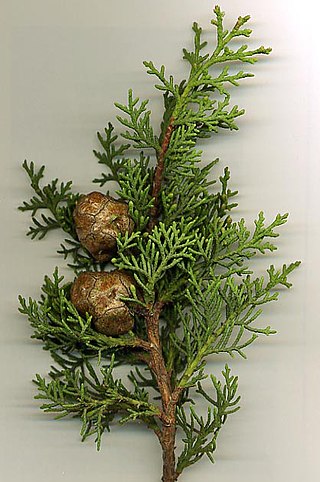
Cupressaceae is a conifer family, the cypress, with worldwide distribution. The family includes 27–30 genera, which include the junipers and redwoods, with about 130–140 species in total. They are monoecious, subdioecious or (rarely) dioecious trees and shrubs up to 116 m (381 ft) tall. The bark of mature trees is commonly orange- to red-brown and of stringy texture, often flaking or peeling in vertical strips, but smooth, scaly or hard and square-cracked in some species.

Tsuga is a genus of conifers in the subfamily Abietoideae of Pinaceae, the pine family. The common name hemlock is derived from a perceived similarity in the smell of its crushed foliage to that of the unrelated plant poison hemlock. Unlike the latter, Tsuga species are not poisonous.
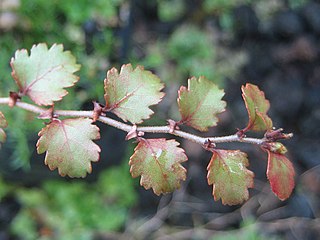
Antarctic flora are a distinct community of vascular plants which evolved millions of years ago on the supercontinent of Gondwana. Presently, species of Antarctica flora reside on several now separated areas of the Southern Hemisphere, including southern South America, southernmost Africa, New Zealand, Australia, and New Caledonia. Joseph Dalton Hooker was the first to notice similarities in the flora and speculated that Antarctica had served as either a source or a transitional point, and that land masses now separated might formerly have been adjacent.

Cunninghamia is a genus of one or two living species of evergreen coniferous trees in the cypress family Cupressaceae. They are native to China, northern Vietnam and Laos, and perhaps also Cambodia. They may reach 50 m (160 ft) in height. In vernacular use, it is most often known as Cunninghamia, but is also sometimes called "China-fir". The genus name Cunninghamia honours Dr. James Cunningham, a British doctor who introduced this species into cultivation in 1702 and botanist Allan Cunningham.
Palissya is an extinct form genus of female (ovule-bearing) conifer cones, known from the Late Triassic (Rhaetian) to the Early Cretaceous (Aptian). The cone of Palissya is noted for its unusual catkin-like construction: Slender bracts are rigidly attached in a helical pattern around a tall woody core. The adaxial (upper) surface of each bract bears two parallel rows of ovules which are encased in cup-like structures formed by scales. The seeds are thin-walled and were likely only viable for a short period of time, meaning that they were probably adapted to wind dispersal.

Elmisaurus is an extinct genus of caenagnathid dinosaur from the Late Cretaceous Nemegt Formation of Mongolia. It was a theropod belonging to the Oviraptorosauria.

Cheirolepidiaceae is an extinct family of conifers. They first appeared in the Triassic, and were widespread during most of the Mesozoic era. They are united by the possession of a distinctive pollen type assigned to the form genus Classopollis. The name Frenelopsidaceae or "frenelopsids" has been used for a group of Cheirolepidiaceae with jointed stems, thick internode cuticles, sheathing leaf bases and reduced free leaf tips. The leaf morphology has been noted as being similar to that of halophyte Salicornia. Several members of the family appear to have been adapted for semi-arid and coastal settings, with a high tolerance of saline conditions. Cheirolepidiaceae disappeared from most regions of the world during the Cenomanian-Turonian stages of the Late Cretaceous, but reappeared in South America during the Maastrichtian, the final stage of the Cretaceous, increasing in abundance after the K-Pg extinction and being a prominent part of the regional flora during the Paleocene, before going extinct.

Gondwana was a large landmass, sometimes referred to as a supercontinent. It was formed by the accretion of several cratons, beginning c. 800 to 650Ma with the East African Orogeny, the collision of India and Madagascar with East Africa, and was completed c.600 to 530 Ma with the overlapping Brasiliano and Kuunga orogenies, the collision of South America with Africa, and the addition of Australia and Antarctica, respectively. Eventually, Gondwana became the largest piece of continental crust of the Palaeozoic Era, covering an area of about 100,000,000 km2 (39,000,000 sq mi), about one-fifth of the Earth's surface. It fused with Euramerica during the Carboniferous to form Pangea. It began to separate from northern Pangea (Laurasia) during the Triassic, and started to fragment during the Early Jurassic. The final stages of break-up, involving the separation of Antarctica from South America and Australia, occurred during the Paleogene (from around 66 to 23 million years ago. Gondwana was not considered a supercontinent by the earliest definition, since the landmasses of Baltica, Laurentia, and Siberia were separated from it. To differentiate it from the Indian region of the same name, it is also commonly called Gondwanaland.
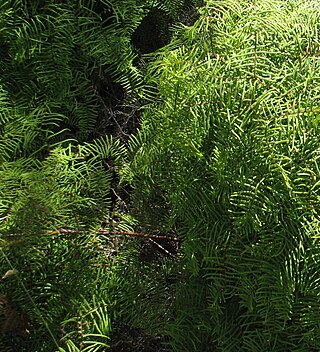
Gleichenia is a genus of ferns. Its closest relative is the genus Stromatopteris, restricted to New Caledonia.
Cunninghamites is an extinct genus of conifers in the family Cupressaceae of the European Late Cretaceous flora.
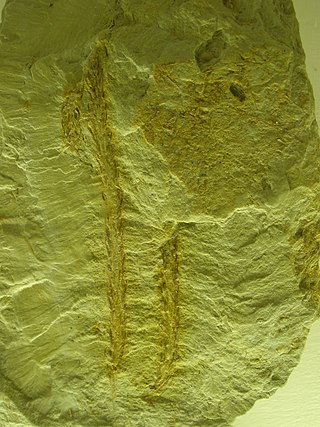
Voltziales is an extinct order of conifers. The group contains the ancestral lineages from which modern conifer groups emerged. Voltzialean conifers are divided into two informal groups, the primitive "walchian conifers" like Walchia, where the ovuliferous cone is composed of radial shoots and the more advanced "voltzian voltziales", also known as "transitional conifers" where the cone is composed of fertile scales with sessile seeds, like those of modern conifers. Walchian conifers generally grew as small trees. The earliest walchian conifers are known from the Middle Pennsylvanian (Moscovian). The youngest walchian conifers are known from the Late Permian. The earliest "voltzian voltziales" are known from the late Early Permian (Kungurian). Modern conifer lineages emerged from voltzialean ancestors from the Late Permian to Jurassic. Voltzialean conifers outside modern groups such as Krassilovia/Podozamites survived into the Cretaceous, before becoming extinct. The genus Voltzia was named in honour of the French geologist Philippe Louis Voltz.

Agathoxylon is a form genus of fossil wood, including massive tree trunks. Although identified from the late Palaeozoic to the end of the Mesozoic, Agathoxylon is common from the Carboniferous to Triassic. Agathoxylon represents the wood of multiple conifer groups, including both Araucariaceae and Cheirolepidiaceae, with late Paleozoic and Triassic forms possibly representing other conifers or other seed plant groups like "pteridosperms".
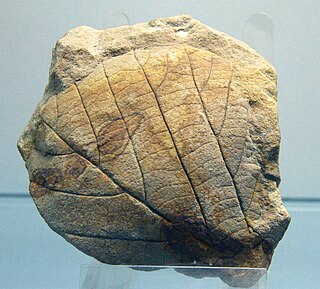
Credneria is an extinct genus in the family or Platanaceae of broad-leaf trees similar to extinct Platanus species that appeared during the Cretaceous. The genus was first described by Zenker (1833) and has formerly been placed in the family Salicaceae rather than Platanaceae on occasion. Credneria leaves are preserved in sandstone and less often in siltstone. The leaves are typically obovate with a pinnate-actinodromous venation and distinct suprabasal veins.

Bauruemys is an extinct genus of turtles in the family Podocnemididae.
Ruflorinia is a genus of fossilized foliage from the Early Cretaceous of Argentina assigned to the order Caytoniales.

Palissyales are an extinct order of conifers, known from the Mesozoic. They are best known from the genus Palissya, which is found in Laurasia and Eastern Gondwana dating from the Late Triassic to Early Cretaceous. The only other confirmed genus of the family, Stachyotaxus known from the Late Triassic of the Northern Hemisphere. The genus Knezourocarpon from the Jurassic of Australia has also been tentatively considered a member of the order. The cone of the best known genus Palissya is noted for its unusual construction, which is borne on a large bract, and consists of two parallel rows of ovules that run along the midline of the adaxial surface of the bract which are encased in cup-like structures formed by scales. The bracts are helically arranged around an axis, forming a compound catkin-like structure. The seeds are thin-walled were likely only viable for a short period of time, and were likely adapted to wind dispersal. Palissya has been considered in some aspects to be similar to some Paleozoic Voltziales, as well as Taxaceae and Podocarpaceae.
Geinitzia is an extinct genus of conifers, with an uncertain position within the group. Species belonging to the genus lived in the late Cretaceous and have been found in Argentina and Europe.
Araucarites is an extinct genus of conifer, used to refer to female conifer cones that resemble those of the family Araucariaceae. Species assigned to the genus lived in the Permian to Eocene and have been found worldwide.
This paleobotany list records new fossil plant taxa that were to be described during the year 2022, as well as notes other significant paleobotany discoveries and events which occurred during 2022.













